Research Project: Accounting Firm's 20-Hour Work Week Evaluation
VerifiedAdded on 2021/06/16
|15
|3703
|227
Project
AI Summary
This research project examines the impact of a 20-hour work week plan implemented by an accounting firm. The study employs a qualitative research approach, utilizing in-depth interviews and open-ended questionnaires to gather data from both staff and clients. The research aims to describe the advantages and disadvantages of the reduced work schedule, identify problems encountered by staff and clients, gather suggestions for improvement, and determine how to maintain the new work plan. The project includes detailed descriptions of the research approach, participant selection, data collection methods, and data analysis steps, including transcription, coding into themes, and generalization of themes. The findings address potential limitations of the work plan, such as reduced staff engagement and potential loss of clients. Furthermore, the project explores the use of mixed methods, including explanatory sequential, exploratory sequential, and convergent parallel methods. The project also defines participatory budgeting and provides relevant literature references.

Research Project 1
RESEARCH PROJECT
By (Student’s Name)
Professor’s Name
College
Course
Date
RESEARCH PROJECT
By (Student’s Name)
Professor’s Name
College
Course
Date
Paraphrase This Document
Need a fresh take? Get an instant paraphrase of this document with our AI Paraphraser
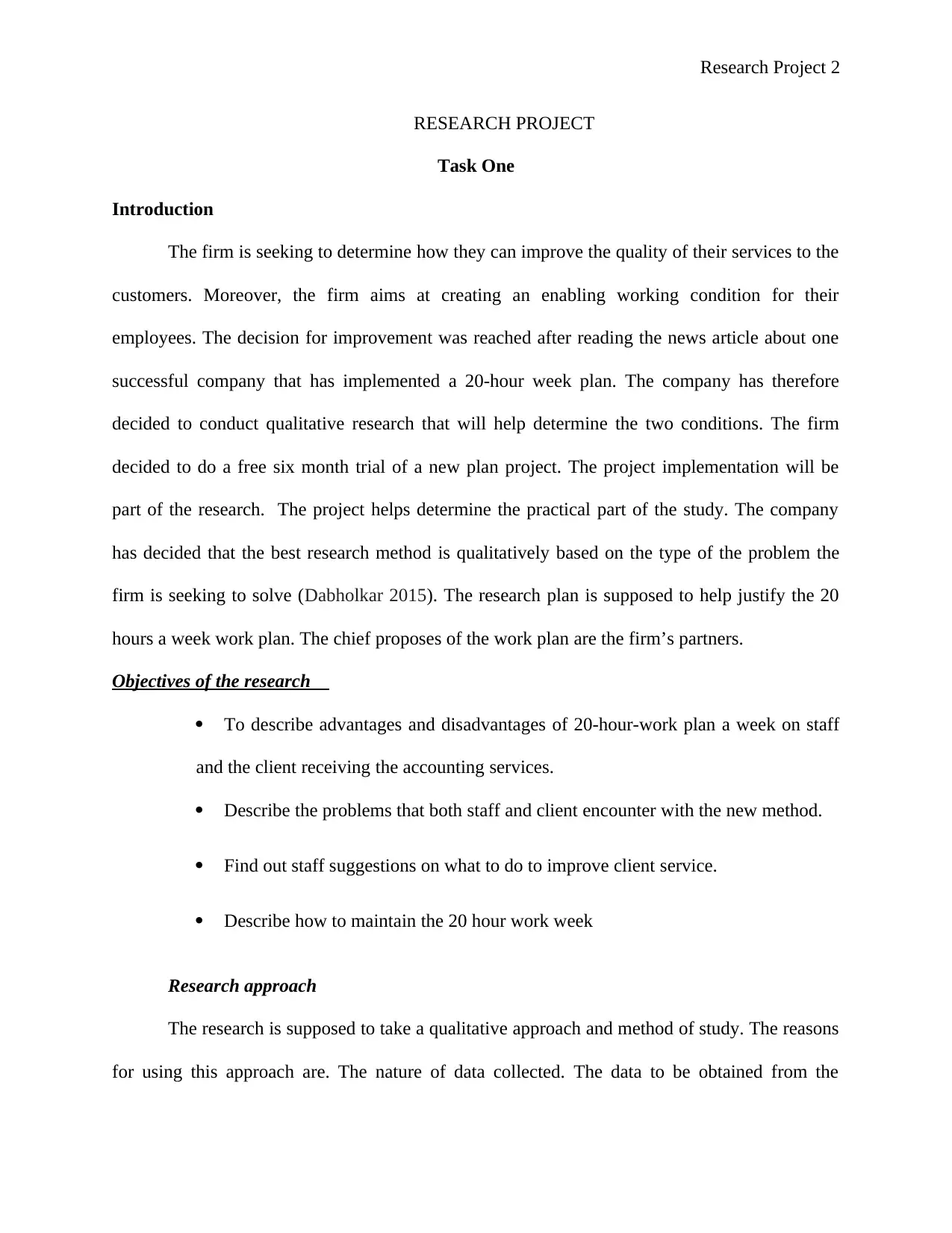
Research Project 2
RESEARCH PROJECT
Task One
Introduction
The firm is seeking to determine how they can improve the quality of their services to the
customers. Moreover, the firm aims at creating an enabling working condition for their
employees. The decision for improvement was reached after reading the news article about one
successful company that has implemented a 20-hour week plan. The company has therefore
decided to conduct qualitative research that will help determine the two conditions. The firm
decided to do a free six month trial of a new plan project. The project implementation will be
part of the research. The project helps determine the practical part of the study. The company
has decided that the best research method is qualitatively based on the type of the problem the
firm is seeking to solve (Dabholkar 2015). The research plan is supposed to help justify the 20
hours a week work plan. The chief proposes of the work plan are the firm’s partners.
Objectives of the research
To describe advantages and disadvantages of 20-hour-work plan a week on staff
and the client receiving the accounting services.
Describe the problems that both staff and client encounter with the new method.
Find out staff suggestions on what to do to improve client service.
Describe how to maintain the 20 hour work week
Research approach
The research is supposed to take a qualitative approach and method of study. The reasons
for using this approach are. The nature of data collected. The data to be obtained from the
RESEARCH PROJECT
Task One
Introduction
The firm is seeking to determine how they can improve the quality of their services to the
customers. Moreover, the firm aims at creating an enabling working condition for their
employees. The decision for improvement was reached after reading the news article about one
successful company that has implemented a 20-hour week plan. The company has therefore
decided to conduct qualitative research that will help determine the two conditions. The firm
decided to do a free six month trial of a new plan project. The project implementation will be
part of the research. The project helps determine the practical part of the study. The company
has decided that the best research method is qualitatively based on the type of the problem the
firm is seeking to solve (Dabholkar 2015). The research plan is supposed to help justify the 20
hours a week work plan. The chief proposes of the work plan are the firm’s partners.
Objectives of the research
To describe advantages and disadvantages of 20-hour-work plan a week on staff
and the client receiving the accounting services.
Describe the problems that both staff and client encounter with the new method.
Find out staff suggestions on what to do to improve client service.
Describe how to maintain the 20 hour work week
Research approach
The research is supposed to take a qualitative approach and method of study. The reasons
for using this approach are. The nature of data collected. The data to be obtained from the
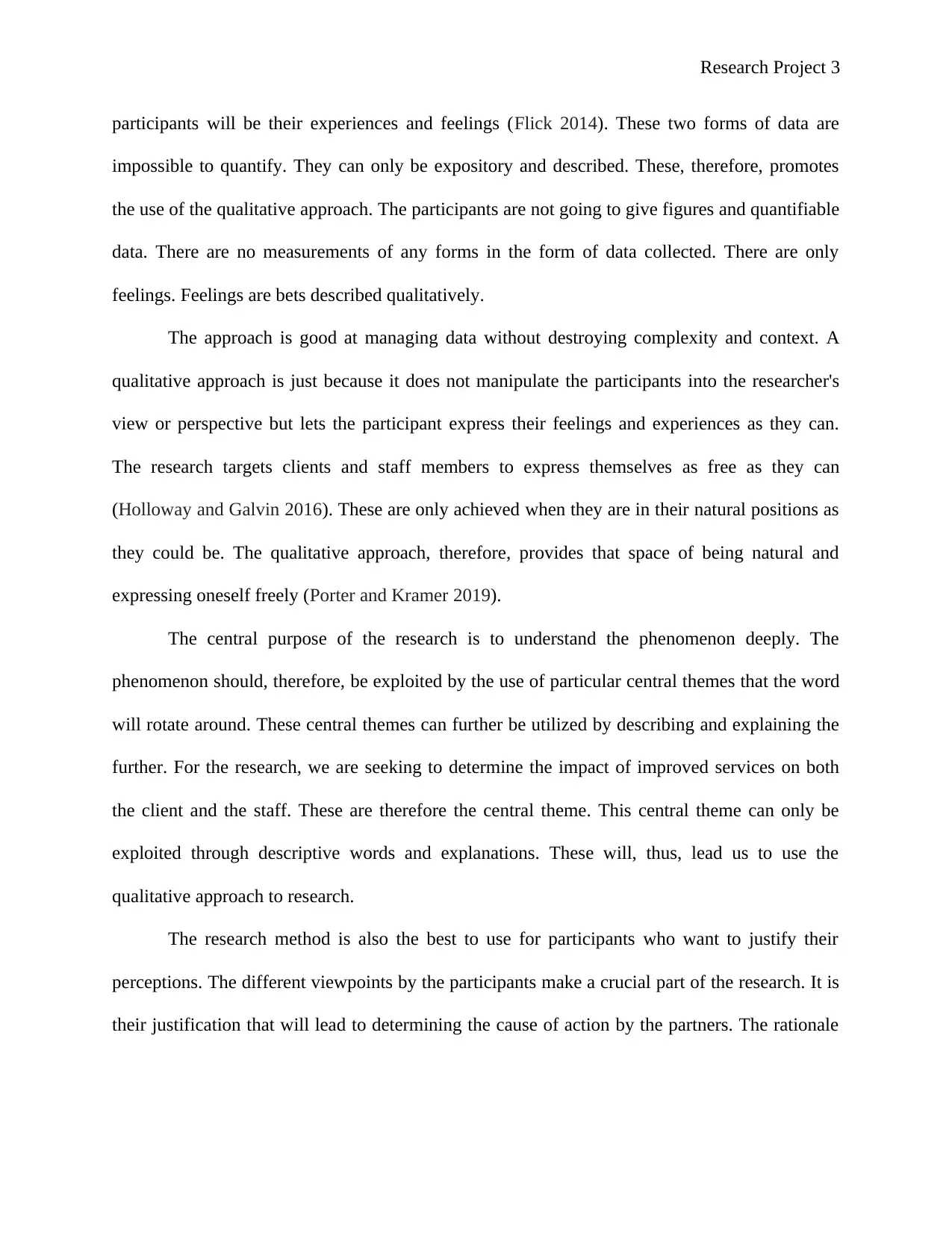
Research Project 3
participants will be their experiences and feelings (Flick 2014). These two forms of data are
impossible to quantify. They can only be expository and described. These, therefore, promotes
the use of the qualitative approach. The participants are not going to give figures and quantifiable
data. There are no measurements of any forms in the form of data collected. There are only
feelings. Feelings are bets described qualitatively.
The approach is good at managing data without destroying complexity and context. A
qualitative approach is just because it does not manipulate the participants into the researcher's
view or perspective but lets the participant express their feelings and experiences as they can.
The research targets clients and staff members to express themselves as free as they can
(Holloway and Galvin 2016). These are only achieved when they are in their natural positions as
they could be. The qualitative approach, therefore, provides that space of being natural and
expressing oneself freely (Porter and Kramer 2019).
The central purpose of the research is to understand the phenomenon deeply. The
phenomenon should, therefore, be exploited by the use of particular central themes that the word
will rotate around. These central themes can further be utilized by describing and explaining the
further. For the research, we are seeking to determine the impact of improved services on both
the client and the staff. These are therefore the central theme. This central theme can only be
exploited through descriptive words and explanations. These will, thus, lead us to use the
qualitative approach to research.
The research method is also the best to use for participants who want to justify their
perceptions. The different viewpoints by the participants make a crucial part of the research. It is
their justification that will lead to determining the cause of action by the partners. The rationale
participants will be their experiences and feelings (Flick 2014). These two forms of data are
impossible to quantify. They can only be expository and described. These, therefore, promotes
the use of the qualitative approach. The participants are not going to give figures and quantifiable
data. There are no measurements of any forms in the form of data collected. There are only
feelings. Feelings are bets described qualitatively.
The approach is good at managing data without destroying complexity and context. A
qualitative approach is just because it does not manipulate the participants into the researcher's
view or perspective but lets the participant express their feelings and experiences as they can.
The research targets clients and staff members to express themselves as free as they can
(Holloway and Galvin 2016). These are only achieved when they are in their natural positions as
they could be. The qualitative approach, therefore, provides that space of being natural and
expressing oneself freely (Porter and Kramer 2019).
The central purpose of the research is to understand the phenomenon deeply. The
phenomenon should, therefore, be exploited by the use of particular central themes that the word
will rotate around. These central themes can further be utilized by describing and explaining the
further. For the research, we are seeking to determine the impact of improved services on both
the client and the staff. These are therefore the central theme. This central theme can only be
exploited through descriptive words and explanations. These will, thus, lead us to use the
qualitative approach to research.
The research method is also the best to use for participants who want to justify their
perceptions. The different viewpoints by the participants make a crucial part of the research. It is
their justification that will lead to determining the cause of action by the partners. The rationale
⊘ This is a preview!⊘
Do you want full access?
Subscribe today to unlock all pages.

Trusted by 1+ million students worldwide

Research Project 4
for the participant’s feelings and perception can only be exploited if the qualitative approach is
used.
The population from which the participants will be selected
The staff participants will be selected from the ones that operate during the working
hours that have so many clients wanting to be served. This time is always between 10 am in the
morning to noon. During this hours the cues usually are very long, and there could be no better
population that staff who work at this time.
The staff will be chosen from the time where the cues are very long. The time when they
serve so many people and therefore the get opinions from so many people. This will be the best
time to get the response from the staff as they have to serve impatient and annoying clients.
These situations provide for the best population to be used.
Determining sample size
The sampling method that would be used helps to determine the size.
The method that would be used in sampling will help determine the sample size that will
be needed. For example, if we use stratified sampling, each stratum will need members.
Therefore we will evaluate sample size from the same. For our case, we are planning to use
random sampling. Consequently the numbers will be picked at random for the size.
The number of responses. Since we have more than five answers for each participant and
we will need instinct and justified a reason to participate (Burwell 2015). This, therefore, means
that we will take a few sample participants from the staffs but the ones who will give an
instinctive response.
How the sample of participants will be chosen
for the participant’s feelings and perception can only be exploited if the qualitative approach is
used.
The population from which the participants will be selected
The staff participants will be selected from the ones that operate during the working
hours that have so many clients wanting to be served. This time is always between 10 am in the
morning to noon. During this hours the cues usually are very long, and there could be no better
population that staff who work at this time.
The staff will be chosen from the time where the cues are very long. The time when they
serve so many people and therefore the get opinions from so many people. This will be the best
time to get the response from the staff as they have to serve impatient and annoying clients.
These situations provide for the best population to be used.
Determining sample size
The sampling method that would be used helps to determine the size.
The method that would be used in sampling will help determine the sample size that will
be needed. For example, if we use stratified sampling, each stratum will need members.
Therefore we will evaluate sample size from the same. For our case, we are planning to use
random sampling. Consequently the numbers will be picked at random for the size.
The number of responses. Since we have more than five answers for each participant and
we will need instinct and justified a reason to participate (Burwell 2015). This, therefore, means
that we will take a few sample participants from the staffs but the ones who will give an
instinctive response.
How the sample of participants will be chosen
Paraphrase This Document
Need a fresh take? Get an instant paraphrase of this document with our AI Paraphraser

Research Project 5
Since we shall have determined the exact number needed in the research, we will require
two methods to select the sample from the general participants.
Snowball sampling. This method focuses on the specific audience that is needed. In this
case since the rise, arch needs appropriate responses about what the research is looking to
determine.
Level of confidence of the participants
Since this research is a qualitative one and requires a lot of justification, the staff who
show high levels of confidence will while being served are the ones who will be selected for the
research. Since it is expected that they will give honest feedback that will help the partners get
the desired result.
Quota sampling
Since the staff of the accounting firm is all professionals. For research purposes, we will
use the specific team that we want. We will engage managers of different capacities. We will
also consider gender in determining the sample that will be used for the research. This type of
sampling focusing on specific individuals will ensure the proper direct feedback. Therefore the
research will use quota and snowball sampling to select sample out of the population (Ross
2017).
Method of data collection
Since the research uses a qualitative approach, the best methods are the ones that could
help the participant express their feelings openly and freely (Gentles, Charles, Ploeg and
McKibbon 2015). The chosen methods for the study are:
Since we shall have determined the exact number needed in the research, we will require
two methods to select the sample from the general participants.
Snowball sampling. This method focuses on the specific audience that is needed. In this
case since the rise, arch needs appropriate responses about what the research is looking to
determine.
Level of confidence of the participants
Since this research is a qualitative one and requires a lot of justification, the staff who
show high levels of confidence will while being served are the ones who will be selected for the
research. Since it is expected that they will give honest feedback that will help the partners get
the desired result.
Quota sampling
Since the staff of the accounting firm is all professionals. For research purposes, we will
use the specific team that we want. We will engage managers of different capacities. We will
also consider gender in determining the sample that will be used for the research. This type of
sampling focusing on specific individuals will ensure the proper direct feedback. Therefore the
research will use quota and snowball sampling to select sample out of the population (Ross
2017).
Method of data collection
Since the research uses a qualitative approach, the best methods are the ones that could
help the participant express their feelings openly and freely (Gentles, Charles, Ploeg and
McKibbon 2015). The chosen methods for the study are:

Research Project 6
In-depth interview. The interview should be in-depth to allow for full expression. This
will, therefore, influence the impact evaluation. The interview is supposed to make us understand
the process of what is observable.
Open-ended questionnaires. The open-ended questionnaire should have general
questions that guide the participant from going astray. However, it is designed to have less
structure protocol so that the participant clarify as much as they can the issues they shall have
raised (Graban 2016).
The method of data collection used is, therefore, open-ended questionnaires and in-depth
interviews.
Research question to participants
Staff
The staff will answer the following questions
What did you like and hate most during the 20 hour work week? This question is
supposed to help in determining the first objective of the research, which is describing the
advantages of the 20 hour work week plan. The problem if answered exhaustively will evaluate
the implementation of the new plan (Glaser and Strauss 2017).
Giving reasons how do you rate it with the previous plan? This question is related to the
last objective. The research will be determining the best plan that fits for the clients according to
the staff opinion. The rating also helps in comparing the plan that is liked most between the two,
so that it is not undermined (Dhar 2015).
What can be done to improve the 20 hour work week plan? This question will help focus
on the last objective. It will determine the adjustments that can be done to ensure that the plan is
readjusted and implemented well.
In-depth interview. The interview should be in-depth to allow for full expression. This
will, therefore, influence the impact evaluation. The interview is supposed to make us understand
the process of what is observable.
Open-ended questionnaires. The open-ended questionnaire should have general
questions that guide the participant from going astray. However, it is designed to have less
structure protocol so that the participant clarify as much as they can the issues they shall have
raised (Graban 2016).
The method of data collection used is, therefore, open-ended questionnaires and in-depth
interviews.
Research question to participants
Staff
The staff will answer the following questions
What did you like and hate most during the 20 hour work week? This question is
supposed to help in determining the first objective of the research, which is describing the
advantages of the 20 hour work week plan. The problem if answered exhaustively will evaluate
the implementation of the new plan (Glaser and Strauss 2017).
Giving reasons how do you rate it with the previous plan? This question is related to the
last objective. The research will be determining the best plan that fits for the clients according to
the staff opinion. The rating also helps in comparing the plan that is liked most between the two,
so that it is not undermined (Dhar 2015).
What can be done to improve the 20 hour work week plan? This question will help focus
on the last objective. It will determine the adjustments that can be done to ensure that the plan is
readjusted and implemented well.
⊘ This is a preview!⊘
Do you want full access?
Subscribe today to unlock all pages.

Trusted by 1+ million students worldwide
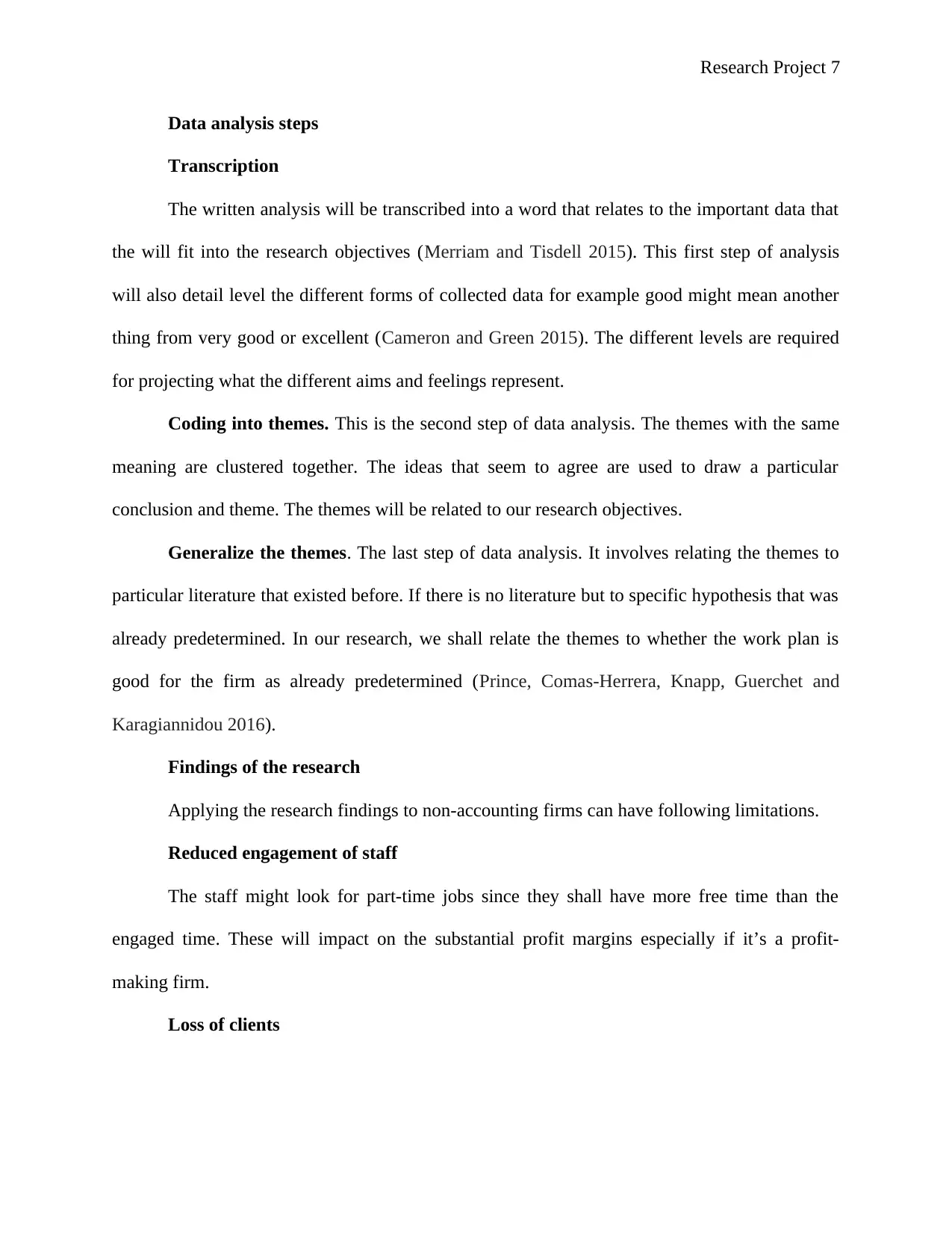
Research Project 7
Data analysis steps
Transcription
The written analysis will be transcribed into a word that relates to the important data that
the will fit into the research objectives (Merriam and Tisdell 2015). This first step of analysis
will also detail level the different forms of collected data for example good might mean another
thing from very good or excellent (Cameron and Green 2015). The different levels are required
for projecting what the different aims and feelings represent.
Coding into themes. This is the second step of data analysis. The themes with the same
meaning are clustered together. The ideas that seem to agree are used to draw a particular
conclusion and theme. The themes will be related to our research objectives.
Generalize the themes. The last step of data analysis. It involves relating the themes to
particular literature that existed before. If there is no literature but to specific hypothesis that was
already predetermined. In our research, we shall relate the themes to whether the work plan is
good for the firm as already predetermined (Prince, Comas-Herrera, Knapp, Guerchet and
Karagiannidou 2016).
Findings of the research
Applying the research findings to non-accounting firms can have following limitations.
Reduced engagement of staff
The staff might look for part-time jobs since they shall have more free time than the
engaged time. These will impact on the substantial profit margins especially if it’s a profit-
making firm.
Loss of clients
Data analysis steps
Transcription
The written analysis will be transcribed into a word that relates to the important data that
the will fit into the research objectives (Merriam and Tisdell 2015). This first step of analysis
will also detail level the different forms of collected data for example good might mean another
thing from very good or excellent (Cameron and Green 2015). The different levels are required
for projecting what the different aims and feelings represent.
Coding into themes. This is the second step of data analysis. The themes with the same
meaning are clustered together. The ideas that seem to agree are used to draw a particular
conclusion and theme. The themes will be related to our research objectives.
Generalize the themes. The last step of data analysis. It involves relating the themes to
particular literature that existed before. If there is no literature but to specific hypothesis that was
already predetermined. In our research, we shall relate the themes to whether the work plan is
good for the firm as already predetermined (Prince, Comas-Herrera, Knapp, Guerchet and
Karagiannidou 2016).
Findings of the research
Applying the research findings to non-accounting firms can have following limitations.
Reduced engagement of staff
The staff might look for part-time jobs since they shall have more free time than the
engaged time. These will impact on the substantial profit margins especially if it’s a profit-
making firm.
Loss of clients
Paraphrase This Document
Need a fresh take? Get an instant paraphrase of this document with our AI Paraphraser
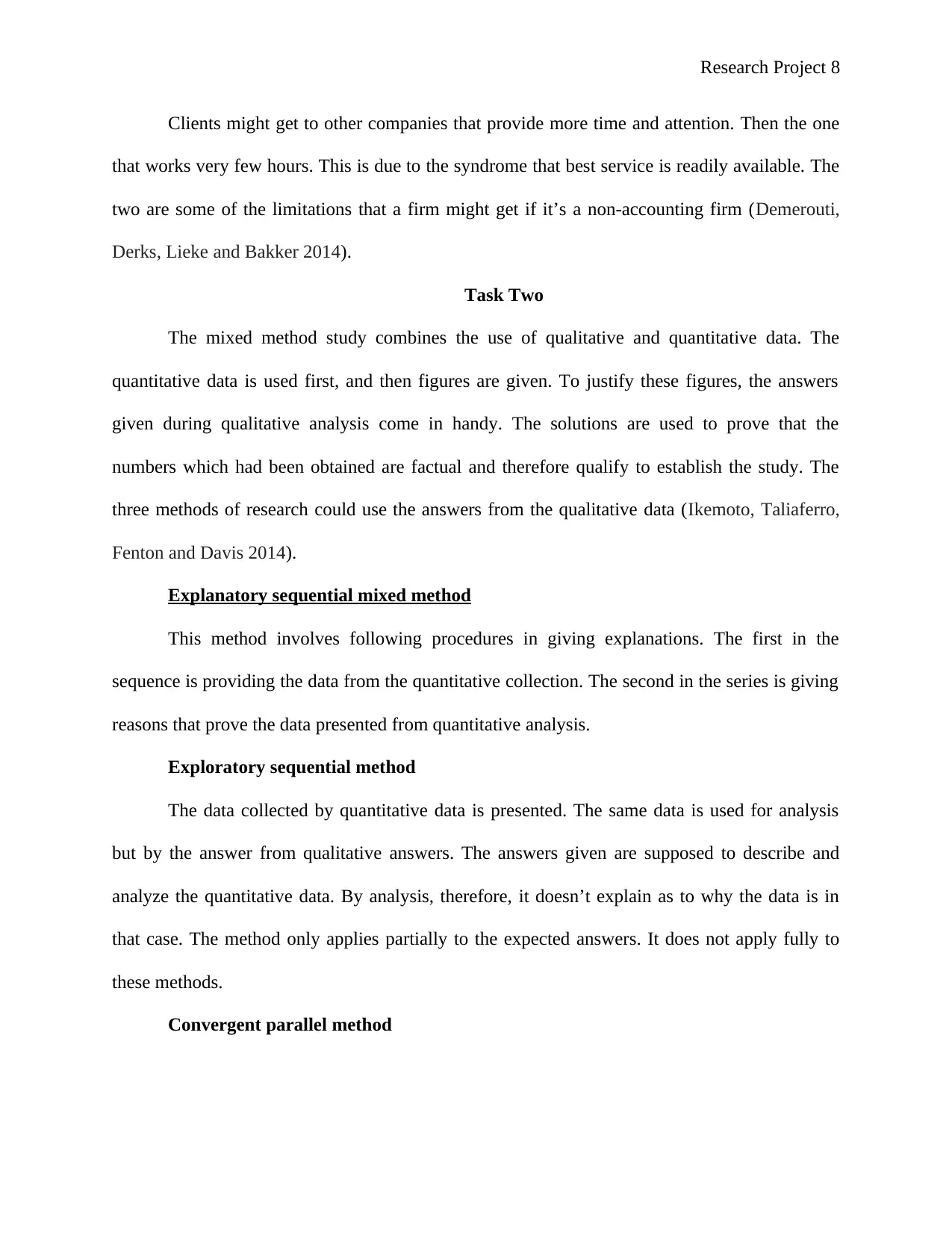
Research Project 8
Clients might get to other companies that provide more time and attention. Then the one
that works very few hours. This is due to the syndrome that best service is readily available. The
two are some of the limitations that a firm might get if it’s a non-accounting firm (Demerouti,
Derks, Lieke and Bakker 2014).
Task Two
The mixed method study combines the use of qualitative and quantitative data. The
quantitative data is used first, and then figures are given. To justify these figures, the answers
given during qualitative analysis come in handy. The solutions are used to prove that the
numbers which had been obtained are factual and therefore qualify to establish the study. The
three methods of research could use the answers from the qualitative data (Ikemoto, Taliaferro,
Fenton and Davis 2014).
Explanatory sequential mixed method
This method involves following procedures in giving explanations. The first in the
sequence is providing the data from the quantitative collection. The second in the series is giving
reasons that prove the data presented from quantitative analysis.
Exploratory sequential method
The data collected by quantitative data is presented. The same data is used for analysis
but by the answer from qualitative answers. The answers given are supposed to describe and
analyze the quantitative data. By analysis, therefore, it doesn’t explain as to why the data is in
that case. The method only applies partially to the expected answers. It does not apply fully to
these methods.
Convergent parallel method
Clients might get to other companies that provide more time and attention. Then the one
that works very few hours. This is due to the syndrome that best service is readily available. The
two are some of the limitations that a firm might get if it’s a non-accounting firm (Demerouti,
Derks, Lieke and Bakker 2014).
Task Two
The mixed method study combines the use of qualitative and quantitative data. The
quantitative data is used first, and then figures are given. To justify these figures, the answers
given during qualitative analysis come in handy. The solutions are used to prove that the
numbers which had been obtained are factual and therefore qualify to establish the study. The
three methods of research could use the answers from the qualitative data (Ikemoto, Taliaferro,
Fenton and Davis 2014).
Explanatory sequential mixed method
This method involves following procedures in giving explanations. The first in the
sequence is providing the data from the quantitative collection. The second in the series is giving
reasons that prove the data presented from quantitative analysis.
Exploratory sequential method
The data collected by quantitative data is presented. The same data is used for analysis
but by the answer from qualitative answers. The answers given are supposed to describe and
analyze the quantitative data. By analysis, therefore, it doesn’t explain as to why the data is in
that case. The method only applies partially to the expected answers. It does not apply fully to
these methods.
Convergent parallel method
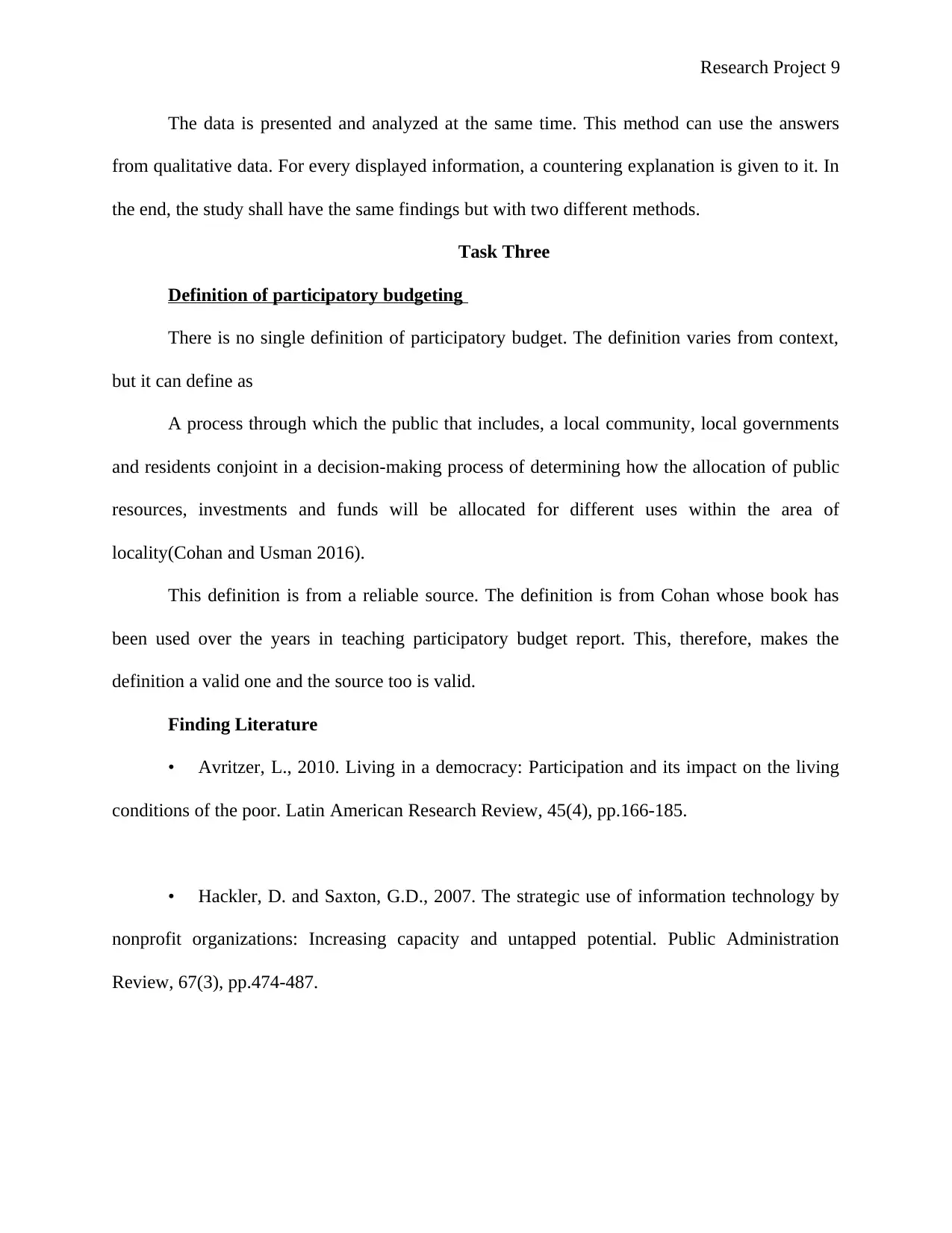
Research Project 9
The data is presented and analyzed at the same time. This method can use the answers
from qualitative data. For every displayed information, a countering explanation is given to it. In
the end, the study shall have the same findings but with two different methods.
Task Three
Definition of participatory budgeting
There is no single definition of participatory budget. The definition varies from context,
but it can define as
A process through which the public that includes, a local community, local governments
and residents conjoint in a decision-making process of determining how the allocation of public
resources, investments and funds will be allocated for different uses within the area of
locality(Cohan and Usman 2016).
This definition is from a reliable source. The definition is from Cohan whose book has
been used over the years in teaching participatory budget report. This, therefore, makes the
definition a valid one and the source too is valid.
Finding Literature
• Avritzer, L., 2010. Living in a democracy: Participation and its impact on the living
conditions of the poor. Latin American Research Review, 45(4), pp.166-185.
• Hackler, D. and Saxton, G.D., 2007. The strategic use of information technology by
nonprofit organizations: Increasing capacity and untapped potential. Public Administration
Review, 67(3), pp.474-487.
The data is presented and analyzed at the same time. This method can use the answers
from qualitative data. For every displayed information, a countering explanation is given to it. In
the end, the study shall have the same findings but with two different methods.
Task Three
Definition of participatory budgeting
There is no single definition of participatory budget. The definition varies from context,
but it can define as
A process through which the public that includes, a local community, local governments
and residents conjoint in a decision-making process of determining how the allocation of public
resources, investments and funds will be allocated for different uses within the area of
locality(Cohan and Usman 2016).
This definition is from a reliable source. The definition is from Cohan whose book has
been used over the years in teaching participatory budget report. This, therefore, makes the
definition a valid one and the source too is valid.
Finding Literature
• Avritzer, L., 2010. Living in a democracy: Participation and its impact on the living
conditions of the poor. Latin American Research Review, 45(4), pp.166-185.
• Hackler, D. and Saxton, G.D., 2007. The strategic use of information technology by
nonprofit organizations: Increasing capacity and untapped potential. Public Administration
Review, 67(3), pp.474-487.
⊘ This is a preview!⊘
Do you want full access?
Subscribe today to unlock all pages.

Trusted by 1+ million students worldwide

Research Project 10
• Allison, M. and Kaye, J., 2011. Strategic planning for nonprofit organizations: A
practical guide and workbook. John Wiley & Sons.
• LeRoux, K., 2009. Paternalistic or participatory governance? Examining opportunities
for client participation in nonprofit social service organizations. Public Administration Review,
69(3), pp.504-517.
Summarizing articles findings
According to the first article public budgeting empower employee and stakeholders to
take a more active role in the development of the organization (Avritzer 2010)
According to the second article participatory budget improve accountability and
transparency for people who hold different positions I the organization (LeRoux 2009).
According to the third article improves relationships between officials of the company
and constituents (Hackler and Saxton 2007)
Shifting of priorities to more pressing concerns of the organization and planning for less
serious one that is according to the fourth article (Allison and Kaye 2011)
Argument of the benefits given above
Greater involvement of people I budgeting of an organization makes issues that were
previously ignored to be considered significant. An investment that can wait are delayed but
planned for while immediate ones are allocated for funds
The participatory budget has led to employees of the organization to have good
relationships with their bosses. This is because they feel connected to them through active
participation (Goetsch and Davis 2014).
• Allison, M. and Kaye, J., 2011. Strategic planning for nonprofit organizations: A
practical guide and workbook. John Wiley & Sons.
• LeRoux, K., 2009. Paternalistic or participatory governance? Examining opportunities
for client participation in nonprofit social service organizations. Public Administration Review,
69(3), pp.504-517.
Summarizing articles findings
According to the first article public budgeting empower employee and stakeholders to
take a more active role in the development of the organization (Avritzer 2010)
According to the second article participatory budget improve accountability and
transparency for people who hold different positions I the organization (LeRoux 2009).
According to the third article improves relationships between officials of the company
and constituents (Hackler and Saxton 2007)
Shifting of priorities to more pressing concerns of the organization and planning for less
serious one that is according to the fourth article (Allison and Kaye 2011)
Argument of the benefits given above
Greater involvement of people I budgeting of an organization makes issues that were
previously ignored to be considered significant. An investment that can wait are delayed but
planned for while immediate ones are allocated for funds
The participatory budget has led to employees of the organization to have good
relationships with their bosses. This is because they feel connected to them through active
participation (Goetsch and Davis 2014).
Paraphrase This Document
Need a fresh take? Get an instant paraphrase of this document with our AI Paraphraser

Research Project 11
The organization's transparency and accountability increases as every employee are
bound to knowing what revenue and profits are made. It is therefore difficult to interfere with
profit and profit margins for fear of getting caught. The authorities, therefore, are responsible and
accountable.
Significance of culture
The theory of Hofstede was used to develop and quantify cultural differences. According
to his 2010 dimension of power generated from his edition of the book cultures and organization.
He developed four dimensions of culture; power distance, individualism, uncertainty, and
masculinity.
A focus on power distance explains that. The less fortunate in a society or a culture,
accept that power is unequally distributed to them. Apart from the acceptance, they also do
expect that power will be unevenly distributed.
Individualism; Hofstede focused on whether people who exist in a particular culture
prefer working alone. He also focused on the reason why they prefer being left alone rather than
operating in public groups.
Culture and participation in budgeting
Research has found out that those on the upper power distance take less interest in
budgetary participation of organization (Sallis 2014.). These findings are based on their job
satisfaction. The people on the lower end of power distance are very interested in the budgetary
participation. They seek to withdraw from the inequality. Therefore job satisfaction alone
connects power distance to budget participation (Merriam and Tisdell 2015).
Factors that influence participation in budgeting
Institutional frameworks
The organization's transparency and accountability increases as every employee are
bound to knowing what revenue and profits are made. It is therefore difficult to interfere with
profit and profit margins for fear of getting caught. The authorities, therefore, are responsible and
accountable.
Significance of culture
The theory of Hofstede was used to develop and quantify cultural differences. According
to his 2010 dimension of power generated from his edition of the book cultures and organization.
He developed four dimensions of culture; power distance, individualism, uncertainty, and
masculinity.
A focus on power distance explains that. The less fortunate in a society or a culture,
accept that power is unequally distributed to them. Apart from the acceptance, they also do
expect that power will be unevenly distributed.
Individualism; Hofstede focused on whether people who exist in a particular culture
prefer working alone. He also focused on the reason why they prefer being left alone rather than
operating in public groups.
Culture and participation in budgeting
Research has found out that those on the upper power distance take less interest in
budgetary participation of organization (Sallis 2014.). These findings are based on their job
satisfaction. The people on the lower end of power distance are very interested in the budgetary
participation. They seek to withdraw from the inequality. Therefore job satisfaction alone
connects power distance to budget participation (Merriam and Tisdell 2015).
Factors that influence participation in budgeting
Institutional frameworks
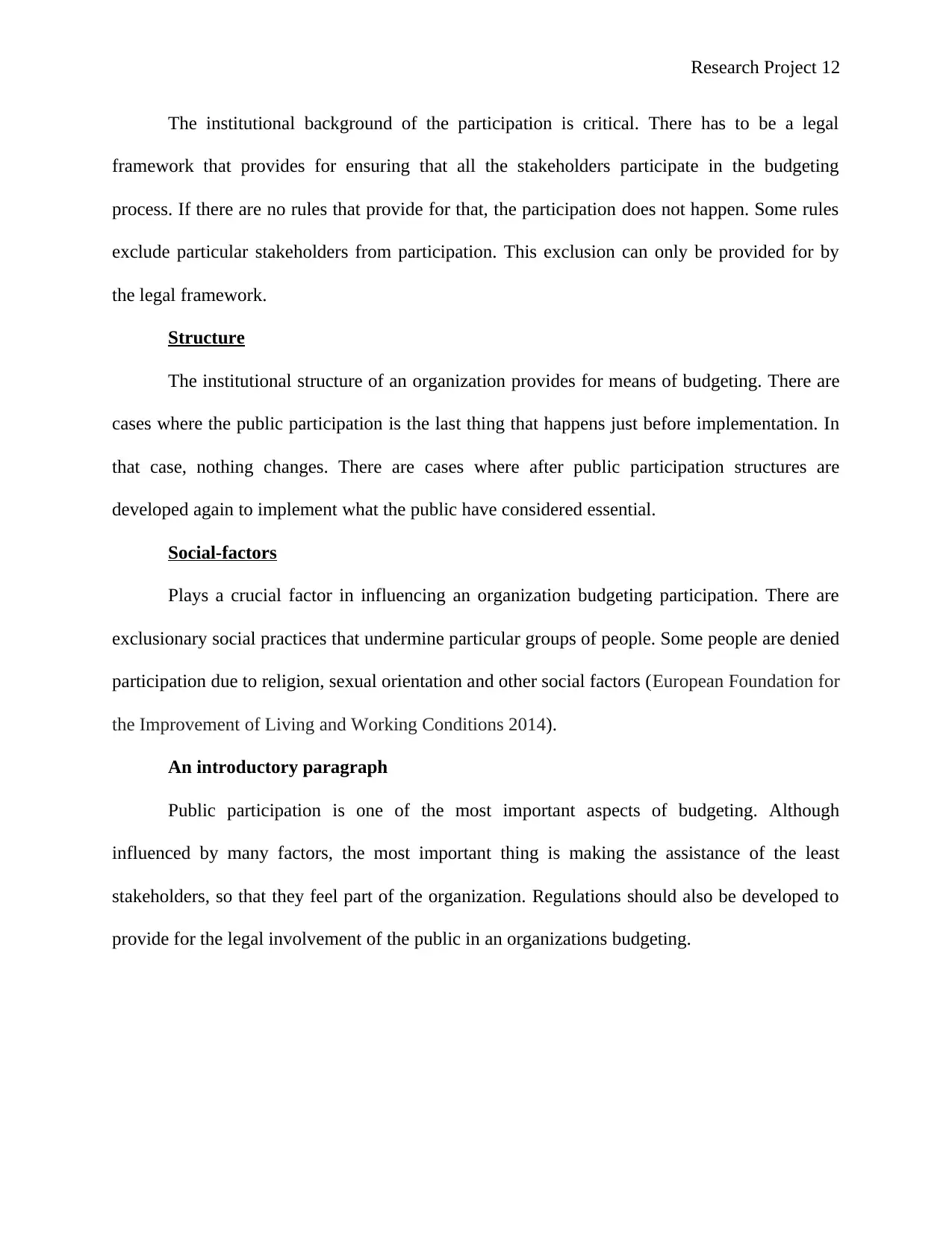
Research Project 12
The institutional background of the participation is critical. There has to be a legal
framework that provides for ensuring that all the stakeholders participate in the budgeting
process. If there are no rules that provide for that, the participation does not happen. Some rules
exclude particular stakeholders from participation. This exclusion can only be provided for by
the legal framework.
Structure
The institutional structure of an organization provides for means of budgeting. There are
cases where the public participation is the last thing that happens just before implementation. In
that case, nothing changes. There are cases where after public participation structures are
developed again to implement what the public have considered essential.
Social-factors
Plays a crucial factor in influencing an organization budgeting participation. There are
exclusionary social practices that undermine particular groups of people. Some people are denied
participation due to religion, sexual orientation and other social factors (European Foundation for
the Improvement of Living and Working Conditions 2014).
An introductory paragraph
Public participation is one of the most important aspects of budgeting. Although
influenced by many factors, the most important thing is making the assistance of the least
stakeholders, so that they feel part of the organization. Regulations should also be developed to
provide for the legal involvement of the public in an organizations budgeting.
The institutional background of the participation is critical. There has to be a legal
framework that provides for ensuring that all the stakeholders participate in the budgeting
process. If there are no rules that provide for that, the participation does not happen. Some rules
exclude particular stakeholders from participation. This exclusion can only be provided for by
the legal framework.
Structure
The institutional structure of an organization provides for means of budgeting. There are
cases where the public participation is the last thing that happens just before implementation. In
that case, nothing changes. There are cases where after public participation structures are
developed again to implement what the public have considered essential.
Social-factors
Plays a crucial factor in influencing an organization budgeting participation. There are
exclusionary social practices that undermine particular groups of people. Some people are denied
participation due to religion, sexual orientation and other social factors (European Foundation for
the Improvement of Living and Working Conditions 2014).
An introductory paragraph
Public participation is one of the most important aspects of budgeting. Although
influenced by many factors, the most important thing is making the assistance of the least
stakeholders, so that they feel part of the organization. Regulations should also be developed to
provide for the legal involvement of the public in an organizations budgeting.
⊘ This is a preview!⊘
Do you want full access?
Subscribe today to unlock all pages.

Trusted by 1+ million students worldwide
1 out of 15
Related Documents
Your All-in-One AI-Powered Toolkit for Academic Success.
+13062052269
info@desklib.com
Available 24*7 on WhatsApp / Email
![[object Object]](/_next/static/media/star-bottom.7253800d.svg)
Unlock your academic potential
Copyright © 2020–2025 A2Z Services. All Rights Reserved. Developed and managed by ZUCOL.




